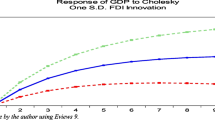Abstract
Using recently developed panel unit root and panel cointegration tests and the Fully-Modified OLS methodology (FMOLS), this paper estimates the impact of remittances on the economic growth of selected upper and lower income Latin American & Caribbean (LAC) countries over the 1990–2007 period. Despite the large flow of remittances to the region, there have been relatively few empirical studies assessing the impact of remittances on economic growth in LAC. Panel unit root tests suggest that several of the macro variables included in the model exhibit unit roots, yet, at the same time, Pedroni’s panel cointegration test determined that there is a cointegrating relationship among the variables in the estimated model. The FMOLS estimates suggest that remittances have a positive and significant effect on economic growth in both groups of countries. The estimates also indicate that both the degree of economic freedom and credit provided by the banking system have a positive and significant effect on economic growth in upper (middle) income LAC countries. The sign of the interaction term between remittances and the credit (and EFI) variables suggest that remittances act as substitutes for these variables. Finally, the effect of remittances on both sets of countries is stronger in the presence of a financial (credit) variable.

Similar content being viewed by others
Notes
The 23 countries in the sample are: Argentina, Belize, Bolivia, Brazil, Colombia, Costa Rica, Dominican Republic, Ecuador, El Salvador, Guatemala, Guyana, Haiti, Honduras, Jamaica, Mexico, Nicaragua, Panama, Paraguay, Peru, St. Lucia, St. Vincent and Grenadines, Trinidad and Tobago, Venezuela, RB.
The two countries for which remittances data was missing for the year 1990 are Guyana and Nicaragua. The missing data were generated via linear extrapolation.
It is important to not confuse economic freedom with political and civil liberties. Countries may confer upon their citizens a substantial amount of political and civil liberty in the form of fair and competitive elections and freedom of the press, but still pursue policies that are inimical to economic freedom such as high levels if taxation and excessive government intervention and regulation.
This study also estimated Eq. (2) with an interaction term between remittances and the EFI variable to determine whether these variables were complements or substitutes.
The panel unit root and panel cointegration estimations were undertaken via EVIEWS7.1 software, while the FMOLS estimations were performed with the RATS6.01 software.
Two upper middle income Caribbean (St. Lucia and St. Vincent and the Grenadines) countries had to be removed from the estimation because the Fraser Institute did not report EFI indexes for them.
References
Acosta, P. A., et al. (2008). Remittances and the Dutch disease. Federal Reserve Bank of Atlanta, Working Paper2007-8a (August), 1–22.
Aitymbetov, S. (2006). Emigrant remittances: impact on economic development of kyrgyzstan. ICEG Working Paper (June), 1–20.
Baltagi, B. H. (2001). Economic analysis of panel data (2nd ed.). New York: Wiley.
Barajas, A., et al. (2009). Do workers remittances promote economic growth? IMF Working Paper, No. 153 (July), 1–22.
Canas, J., Coronado, R., & Orrenius, P. (2007). Explaining the increase in remittances to Mexico. The Southwest Economy, Federal Reserve Bank of Dallas.
Chami, R., Fullenkamp, C., & Jahjah, S. (2005). Are immigrant remittance flows a source of capital for development? IMF Staff Papers, 53(1).
ECLAC. (2006-11). Foreign investment in Latin America and the Caribbean, various reports.
Ellerman, D. (2003). Policy research on migration and development. World Bank Policy Research Working Paper, No. 3117. Washington, D.C.: The World Bank.
Engle, R. F., & Granger, C. W. J. (1987). Cointegration and error correction: representation, estimation, and testing. Econometrica, 55, 251–276.
Giuliano, P., & Ruiz-Arranz, M. (2006). Remittances, financial development, and growth. IMF Working Papers no.05-234, June.
Gupta, P. (2005). Macroeconomic determinants of remittances: evidence from India. IMF Working Papers 05/224.
Hadri, K. (2000). Testing for stationarity in heterogeneous panel data. The Econometrics Journal, 3(2), 148–161.
Im, K. S., Pesaran, M. H., & Shin, Y. (2003). Testing for unit roots in heterogeneous panels. Journal of Econometrics, 115(1), 53–74.
Levin, A., Lin, C., & James Chu, C. (2002). Unit root tests in panel data: asymptotic and finite-sample properties. Journal of Econometrics, 108(1), 1–24.
Mundaca, G. (2005). Can remittances enhance economic growth? the role of financial market development SSRN. Retrieved from http://ssrn.com/paper=799484.
Orozco, M. (2004). Remittances to Latin America and the Caribbean: Issues and perspectives on development. Washington, D.C.: Organization of American States.
Pedroni, P. (1996). Fully modified OLS for heterogeneous cointegrated panels and the case of purchasing power parity. Indiana University Working Papers in Economics, (No. 96-020).
Pedroni, P. (1999). Critical values for cointegration tests in heterogeneous panels with multiple regressors. Oxford Bulletin of Economics and Statistics, 61(4), 653–670.
Pedroni, P. (2000). Fully modified OLS for heterogeneous cointegrated panels. Advances in Econometrics, 15, 93–130.
Ratha, D. (2003). Workers’ remittances: an important and stable source of external development finance. Global development finance. Washington, D.C.: The World Bank.
Solimano, A. (2003). Remittances by emigrants: issues and evidence. Macroeconomias del Desarrollo, 26, Economic Development Division. Santiago: Chile, October.
The World Bank. (2011). Migration and development brief. Washington, D.C.: Migration and Remittances Unit.
Woodruff, C. (2006). Mexican microenterprise investment and employment: role of remittances. INTAL-ITD Working Paper 26.
World Bank. (2008-10). World development indicators. Washington, D.C.
World Bank. (2009). World development report: reshaping economic geography. Washington, D.C.
Ziesemer, T. (2006). Worker remittances and growth: the physical and human capital channels. UNU-MERIT Working Paper Series, no.0.
Acknowledgments
The author acknowledges the useful comments of reviewers of a previous version of this manuscript.
Author information
Authors and Affiliations
Corresponding author
Rights and permissions
About this article
Cite this article
Ramirez, M.D. Do Financial and Institutional Variables Enhance the Impact of Remittances on Economic Growth in Latin America and the Caribbean? A Panel Cointegration Analysis. Int Adv Econ Res 19, 273–288 (2013). https://doi.org/10.1007/s11294-013-9407-2
Published:
Issue Date:
DOI: https://doi.org/10.1007/s11294-013-9407-2
Keywords
- Credit
- Economic freedom index (EFI)
- FMOLS
- Latin America & Caribbean
- Remittances and growth
- Panel cointegration
- Panel unit roots




